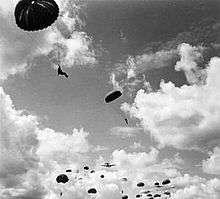1st Battalion, Parachute Regiment
| 1st Battalion, Parachute Regiment | |
|---|---|
 Cap badge of the Parachute Regiment | |
| Active |
1941–1948 1948–Present |
| Country |
|
| Branch |
|
| Type | Airborne infantry |
| Role | Special operations light infantry |
| Size | One battalion |
| Part of | UK Special Forces |
| Nickname(s) | Sporting First |
| Motto(s) |
Utrinque Paratus (Latin for "ready for anything") |
| Insignia | |
| Identification symbol |
|
The 1st Battalion, Parachute Regiment (1 PARA), forms the United Kingdom's Special Forces Support Group (SFSG).[1]
An airborne light infantry unit, the battalion has since 2006 been the main contributor of manpower to the Special Forces Support Group (SFSG) and is capable of a wide range of operations. Personnel regularly deploy outside the United Kingdom on operations and training.
All personnel complete the Pre Parachute Selection (P Company) course at the Infantry Training Centre Catterick Garrison, North Yorkshire (previously at Aldershot, Hampshire).
1 PARA is permanently attached to the SFSG. Once selected, they receive further training on additional weapons, communications equipment and specialist assault skills.[2]
Under Army 2020, it is expected that 1 PARA will remain as part of the SFSG.[3][4]
History

The 1st Battalion can trace its origins to 1940, when No. 2 Commando trained as parachutists. In 1941, the battalion was assigned to the 1st Parachute Brigade which also included the 2nd and 3rd battalions. The 1st Parachute Brigade was part of the 1st Airborne Division and remained with it throughout the war.
The battalion took part in operations in Tunisia in late 1942 to May 1943, suffering heavy casualties. The battalion and the brigade took part in Operation Fustian, when the Allies invaded Sicily and, again, suffered heavy casualties and was withdrawn to England in late 1943 to train and prepare for the Allied invasion of France. The battalion wasn't used in the initial invasion on 6 June 1944, D-Day, but was held back in the UK in reserve in case any of the five invasion beaches encountered serious difficulties and needed support. The plan turned out not to be required. During the fighting in Normandy numerous plans to drop the 1st Airborne were formed, none of which came to fruition. Finally, in September 1944, the battalion dropped into Arnhem the Netherlands with the rest of the 1st Airborne Division, as part of Operation Market Garden, where they suffered extremely heavy casualties and never saw combat again for the rest of the war.
After the war the battalion was reconstituted in 1946, and affiliated to the Brigade of Guards and served with the 6th Airborne Division in Palestine. It was disbanded in 1948, only to be reformed by the renumbering of the 4th/6th Battalion. The battalion was part of Operation Musketeer in 1956.
In the 1970s, the battalion first deployed to Northern Ireland in Operation Banner. The battalion was central to the events of both the Ballymurphy Massacre[5] in August 1971 and the more infamous Bloody Sunday, 30 January 1972, when they opened fire on unarmed civil rights demonstrators leaving 14 civilians dead and 13 wounded, the greatest killing of British subjects by government forces in one incident since the Anglo-Irish War.[6] The second official inquiry of the killings found 1st Para's actions "unjustified and unjustifiable".[7] To date, none of the members of 1 Para have been prosecuted.
The battalion was involved in the NATO operation in Kosovo in 1999, Operation Agricola.[8] One Company was also selected to provide support for the Special Air Service in Sierra Leone during Operation Palliser in 2000. In 2003, they were deployed to the Persian Gulf for Operation Telic in Iraq where despite overwhelming odds, two multiples of No. 8 platoon managed to fight their way out of the town of Majar al-Kabir. The battle took place in June 2003, in the post-invasion period of the Iraq War. During the battle, six Royal Military Policeman of 156 Provost Company were killed by an angry mob.[9]
See also
References
- ↑ "The Parachute Regiment". British Army. Retrieved 25 October 2013.
- ↑ "1 PARA". British Army. Archived from the original on 27 December 2011. Retrieved 25 October 2013.
- ↑ "Regular Army Basing Matrix by Formation and Unit" (PDF). Army Families Federation. Archived from the original (PDF) on 14 August 2016. Retrieved 25 October 2013.
- ↑ "Transforming the British Army (Annex D, Appendix 1)" (PDF). Reserve Forces and Cadets Association for Yorkshire and The Humber. Archived from the original (PDF) on 16 June 2013.
- ↑ McCann, Eamonn (30 January 2014). "Bloody Sunday Revisited". CounterPunch. Retrieved 22 December 2017.
- ↑ "PMs Statement". Bloody Sunday Inquiry. 29 January 1998. Archived from the original on 21 April 2003.
- ↑ "Bloody Sunday Report Released - Bloody Sunday Killings Called 'Unjustified and Unjustifiable'". Gather.com. 15 June 2010. Archived from the original on 29 October 2013. Retrieved 15 July 2010.
- ↑ http://www.eliteukforces.info/parachute-regiment/parachute-regiment-history/kosovo.php
- ↑ Blair, David (26 June 2003). "Last stand at Majar al-Kabir". The Daily Telegraph. Retrieved 4 August 2017.